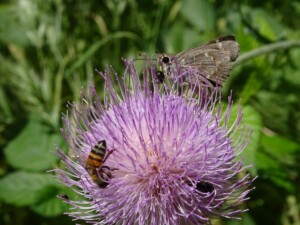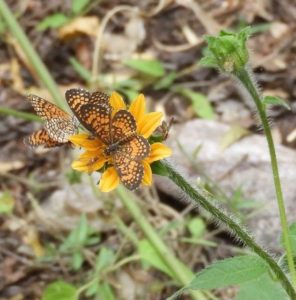The Sky Islands of southeastern Arizona and northern Sonora are home to a diverse range of pollinator species, including insects (like bees and butterflies), hummingbirds, and bats. U.S. Fish and Wildlife Service refers to the Southwest as a hotspot for pollinators due to the various ecosystems that converge here, with the Sierra Madre, the Rocky Mountains, and the Sonoran Desert being just a few of them.
Pollinator diversity is a part of a healthy ecosystem. By moving pollen from one part of a flowering plant to another, pollinators help ensure the development of fruits and seeds—food that other species rely on. In the Sky Islands however, pollinators like insects and hummingbirds are in decline due to climate change, habitat loss, and the use of land for agriculture and development. These obstacles negatively impact the growth of flora and interrupt the migration pathways between the U.S. and Mexico.
Researchers and scientists who have studied these declines call for immediate and critical restorative action to help support pollinator growth and biodiversity. As part of this effort, Carianne Campbell at Strategic Habitat Enhancements in Tucson recently published an article in Air, Soil and Water Research titled, “An Approach for Creating Site-Specific Planting Palettes to Support Pollinators in the Sky Islands.”
Campbell’s article introduces a plan that helps land managers, researchers, and gardeners support pollinator populations. The plan—the first of its kind to focus specifically on the Sky Island region—recommends following four steps for choosing which plants to grow when creating and managing restoration projects in gardens, migration pathways, and pollinator corridors. “The result,” the article states, “is a tool that can be used to visualize a plant palette by its collective bloom phenologies and can be used to predict and evaluate whether … a site could be augmented with additional species.”
Here are the steps Campbell recommends following:
- Start by creating an inventory of existing plants. What’s already growing in the area? Conducting several surveys can help ensure that most species are accounted for.
- Jot down information about the species you’ve surveyed. What time of year do they bloom and seed? What elevations do they grow at? Are there any non-native species present? (See the article for more considerations.)
- When a baseline of current flora has been created, determine which plants should be added to fill in the gaps. Do all existing flora bloom only in the spring? Consider planting some that bloom in the fall to address pollinator needs. Other gaps may include adding host plants that support insect larvae or are tolerant to fire and drought events.
- Note: The goal of Campbell’s pollinator palette plan is to enhance flora biodiversity where it’s been lost. Considering the provenance of your palette and using as native a flora as possible will help support pollinators while remaining cognizant of the region’s delicate ecosystems and habitats.
- After planting supplemental species, monitor how the landscape’s new diversity works to determine success or potential areas of improvement. What’s blooming? Is the seasonal coverage working? How many pollinator species have been detected? Make adaptations and adjustments as necessary.
Campbell’s research encourages the creation of a native, botanical richness that will restore declining pollinator populations as well as benefit landscape restoration after wildfires, food and shelter for non-pollinator species, and the repair of degraded ecosystems.
To learn more about her pollinator planting palette design, check out An Approach to Creating Site-Specific Planting Palettes to Support Pollinators in the Sky Islands.
References:


